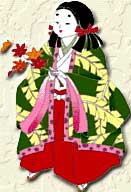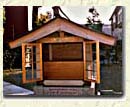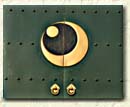 ‘History
 Once in the feudal days, there was a woman by the name of Yugao-hime (Lady Yugao) among Chiba Tsunetane's clan in the district of Sobu (mainly present-day Tokyo, Saitama and Chiba Prefectures). When the Chiba family gradually came to acquire power in the district, Yugao-hime took up her abode in Motogi in the province of Bushu (present-day Tokyo and Saitama Pref.) in her later years. There she, though not tonsured, came to lead a nun-like life, hanging an image of Amida on the wall in her living room and always reciting the nenbutsu (recitation of Amida's name) in devotion to Amida Buddha. She then built a hall housing an image of Amida Buddha and held the morning and evening services there every day. After completing her allotted span of life, she was given a Buddhist name Myoen.  This hall was then rebuilt into a temple as a place of worship for devout men and women, which evolved into the origin of our present temple, Zuiho-ji. The temple was looked after by its keeper and continued to be a place of worship for people for a long time. According to Shinpen Musashi Fudoki Ko [New Version of the Manuscript of the Gazetteer of the Province of Musashi], "Zuiho-ji, which is called Ashura-zan, is said to have had its origin in the seventh year of Meio (1498). Its principal image of Kannon is enshrined in the Temple." This description is considered to mean the Temple, after a long period of the keepers' care, grew into a full-fledged Buddhist temple in those days and began to function wholly as such under the patronage of the Chiba family. ‘The Temple
began to flourish with an increasing number of followers and supporters
from around that time and came to be known as a temple of established
reputation complete with seven buildings, which suggests the Temple
once had a grand size of compound.
 In the Early Modern Age, Hojo Soun started on the invasion of the eight provinces of Kanto with Odawara Castle in Sagami (present-day Kanagawa Prefecture) as the base of operation. The Hojo family's rule gradually expanded to the eastern part of Bushu in the days of his son Ujitsuna and his grandson Ujiyasu, and the Chiba family came under the control of the Hojos by doom of battle. As a result, the noted bell at the belfry of the Temple, which was connected with the Chiba family then, was taken out as a war trophy. As a ship carrying the bell went down the Sumida river for a while, the bell began to groan in a strange, yet impressive sound, and at the same time the wind and waves began to rise as if it had incurred the dragon King's anger. The crewmen and warriors on board were all frightened at the unexpected surprising thing and ran away after sinking the bell in the river. Hence people began to call the place Kanegabuchi or the Deep Pool of the Bell. It is said that the bell could be seen vaguely in the water until the early years of the Meiji era when the water of the river was clear. The notes of Mr. Seta Touemon, who once lived here in the Tokugawa period, states: "The tax-exempt compound of the Temple is 2,818 tsubo (a tsubo is about 3.306 square meters or 3.954 square yards)." This description also gives us a glimpse of the size of the Temple in those days.
|
||||||||||||||||||
